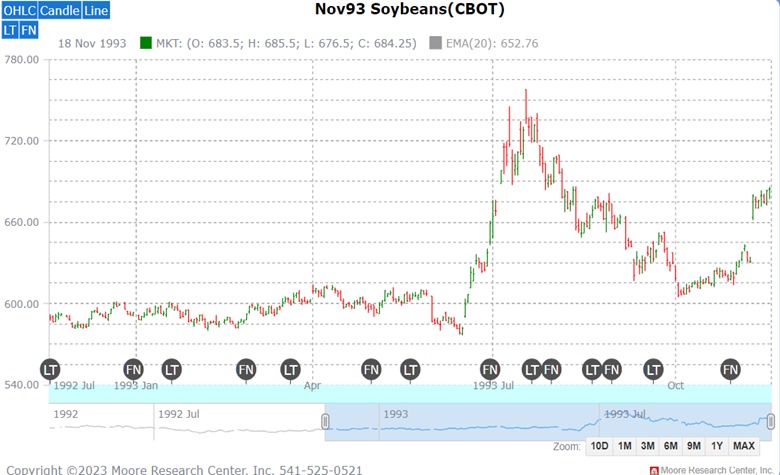1,000 Year Flood takes its toll on agriculture supply chain!
By Devin Lashley
Farms.com Risk Management Intern
Photo Credit: John Metzner, X; A railway bridge collapses into a river due to heavy flooding in the US state of Iowa
The U.S. Midwest is experiencing one of the wettest Junes in a long time and the North/Central regions including SE South Dakota, NW Iowa and SW Minnesota have just witnessed a 1,000-year historic flood. Some are comparing the flood of 2024 to the flood of 1993.
Many areas received as much as 15-18 inches of rain in less than one week with more rain in the forecast. Some experts and analysts are forecasting a loss of one million acres of corn and soybeans while World Weather has projected that 10% of the U.S. Midwest has been impacted. A disaster emergency has been declared for 21 counties in northwest and northern Iowa.
The fund community initial reaction was to continue selling grain futures with no changes based on the concept that “rain makes grain.” The USDA is expected to report the June acreage report on June 29th -- it is expectd to be a market moving report, but the USDA will take time to quantify the damage. It may wait until this fall or wait until the September 30th Sept. quarterly U.S. grain stocks report. The USDA is well-known for “slow walking” any changes to production, acres, yields and demand.
The flooding in the Midwest has broader implications for the agricultural supply chain. Mike Steenhoek of the Soy Transportation Coalition expressed concern about the damage to rural infrastructure, such as roads and bridges, which is crucial for grain transportation.
The collapse of a BNSF Railway bridge near Sioux City, a major grain hub, shows the impact on transportation routes. Disruptions in grain and livestock movement can lead to congestion, less reliable service, and increased shipping costs, affecting the entire supply chain.
Excess moisture is also threatening harvest progress and crop yields in other parts of the Midwest. In Minnesota, persistent rain has led to drowned or flooded crops, with some areas being replanted multiple times. This has resulted in significant yield losses, with some farmers potentially losing 10-15% of their yield potential. Similar issues are reported in Wisconsin, where farmers are struggling to plant and harvest crops due to the continuous rain.
For farmers in western Iowa, the growing season has shifted from concerns of drought in April to flooding in June. Up to 15 inches of rain fell in some areas, leading to a disaster proclamation for several counties. Leah Ten Napel, an Iowa State University Extension field agronomist, reported extensive damage to crops and livestock. While some fields may recover if water recedes quickly, others still underwater will likely see crop loss. The flooding has also affected low-lying areas of fields that had been replanted due to earlier rain, with standing water now exceeding previously affected areas.
The long-term impact of these floods on grain prices remains uncertain. In 1993, similar flooding led to a significant increase in corn futures of 15.5% in the month of July and a 31.5% increase in soybean futures. Could 2024 repeat? Unless the markets see a significant reduction to yields or acres as a result of these floods, the markets may go back to business as usual and “rain makes grain.”


For daily information and updates on agriculture commodity marketing and price risk management for North American farmers, producers, and agribusiness visit the Farms.com Risk Management Website to subscribe to the program.